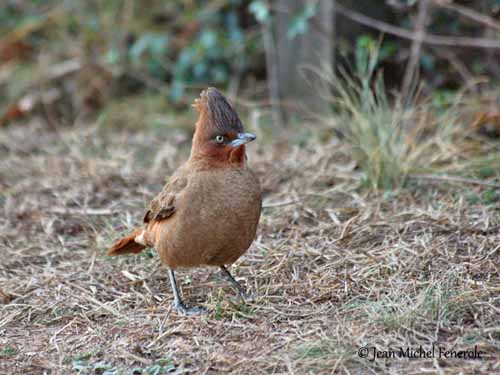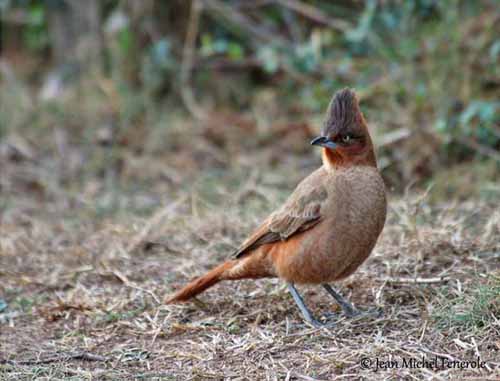
Fr: Cacholote brun
All : Dunkelbrauner Cachalote
Esp : Cacholote Castaño
Ital : Cacialote bruno
Nd: Bruine Cachalote
Sd: Brun cacholote
Port: Coperete
Photographers:
Jean Michel Fenerole
Photos d’Oiseaux du monde
Eduardo Andrés Jordan
MIS AVES – AVES DE ARGENTINA
Philippe et Aline Wolfer
GALERIE
Text by Nicole Bouglouan
Sources:
HANDBOOK OF THE BIRDS OF THE WORLD Vol 8 By Josep del Hoyo-Andrew Elliott-David Christie - Lynx Edicions - ISBN: 8487334504
BirdLife International (BirdLife International)
JUMARA.com.ar - La conservación parte del conocimiento
XENO-CANTO – Sharing Birds sounds from around the world
Brown Cacholote
Pseudoseisura lophotes
Passeriforme Order – Furnariidae Family
BIOMETRICS:
Length: 24-26 cm
Weight: 63-79 g
DESCRIPTION:
The Brown Cacholote is mainly terrestrial, often seen running on the ground. This species is one of the largest Furnariidae.
The adult of nominate race “lophotes” has rufous plumage overall with duller lower back where we can see some pale feather edges. The rump is bright rufous, but the uppertail-coverts are slightly darker. The upperwing shows dark fuscous-brown flight feathers with narrow paler edges, and the wing-coverts are duller with paler tips. The tail is dull dark rufous and slightly rounded.
On the underparts, the throat is bright cinnamon-rufous. The breast is duller and darker with pale-tipped feathers extending into belly and body sides. Lower belly, flanks and undertail-coverts are brighter, with pale tips to longest coverts.
On the head, the face is dull dark rufous with darker forehead. The crown is darker brown with slightly streaked effect. Several elongated feathers form a crest. When they are flattened, they cover the bright rufous hindcrown.
The bill is two-tones with greyish base and blackish mandibles. The eyes are pale yellow. Legs and strong feet are blue-grey to dull greenish.

Both sexes are similar.
The juvenile has finely mottled breast and belly, shorter crest and dull greenish eyes.
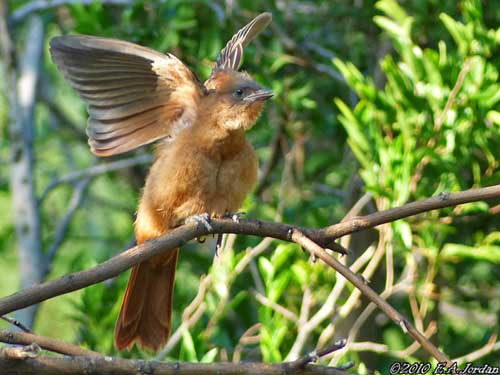
We find two subspecies:
P.l. lophotes is found in S Bolivia and W Paraguay. (Described above)
P.l. argentina is found in N and C Argentina, extreme SE Brazil and Uruguay.
This species here displayed is darker, with less grey-brown anterior crest feathers which appear narrower and more rufous.
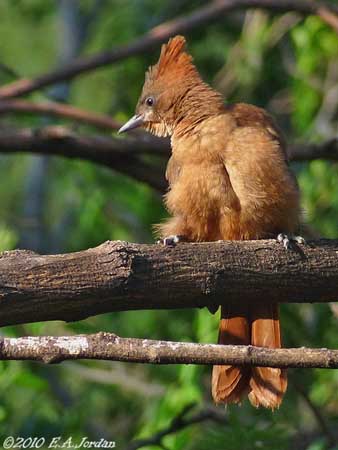
VOICE: SOUNDS BY XENO-CANTO
The Brown Cacholote utters strident sounds and performs duets. The song is a long and loud series of various grating, coarse notes, fading towards the end. This long series can last up to 15 seconds.
The usual call is a “krok” note.
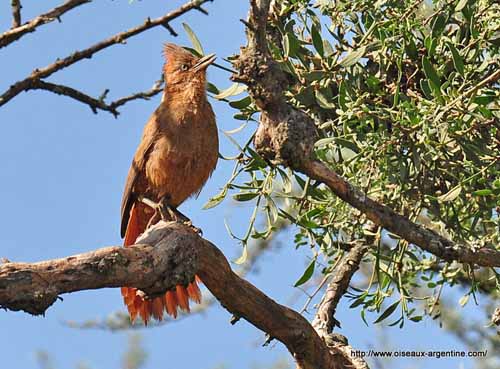
HABITAT:
The Brown Cacholote frequents open mountainous areas up to 900 metres of elevation. It can be seen in areas with scattered trees and scrub, gallery-forest edge, tropical deciduous forest, urban parks and gardens. It usually favours dry areas.
RANGE:
See above in “subspecies”.
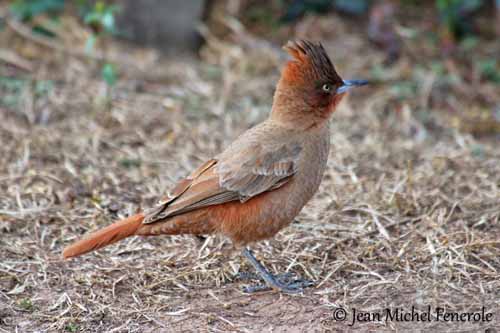
BEHAVIOUR:
The Brown Cacholote feeds on numerous insect species, adults and larvae. It also takes birds’ eggs, seeds and some fruits.
It forages in small groups or in pairs, walking, running and hopping on the ground. It gleans, probes and digs into the soil, among the leaf-litter and even in dung where it searches for arthropods.
It may sometimes hammer and pull bark and leaf buds.
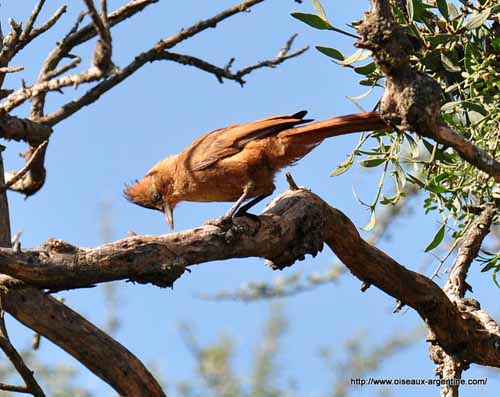
This species also forages in trees with some acrobatic manoeuvres, in order to reach the food. This bird has strong grasping power, thanks to the large feet.
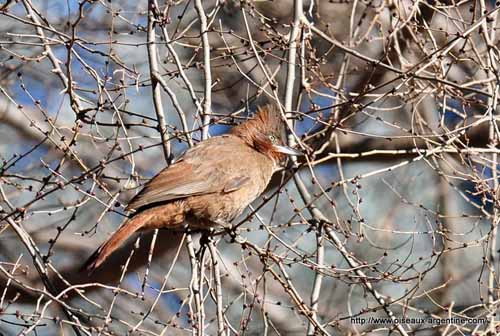
The Brown Cacholote performs duets and displays as advertising territorial signs towards potential rivals, and to strengthen the pair-bonds between mates.
They are probably monogamous, and may stay together all the year, and more, but in this species, the pair-bonds vary in duration and may last only one season.
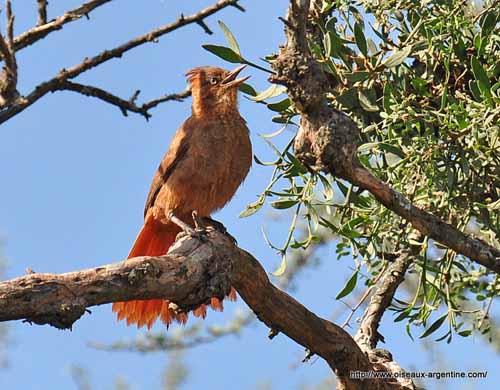
This species is resident in its range.
FLIGHT:
The Brown Cacholote, as several Furnariidae species, has relatively short, rounded but slightly pointed wings which reflect its sedentary status and mainly terrestrial foraging behaviour.
REPRODUCTION:
The breeding season occurs during austral spring/summer.
The Brown Cacholote builds a bulky nest, a large mass of 50-150 cm long and 45-90 cm wide. This nest is made with large sticks (up to 70 cm), with external lateral entrance tube of 30-40 cm long, and supported by horizontal branch. There is a nest-chamber in the inner part of the structure, of 20-25 cm in diameter, occasionally lined with pieces of plant materials, twigs and dung.
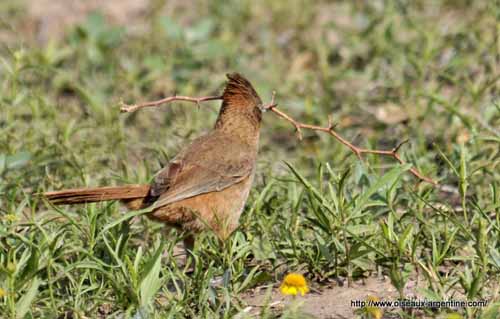
Such nest is placed at about 4-6 metres above the ground, near the top of a small tree or scrub. Some branches are incorporated into the nest which is often built on the same place every year.
The female lays 2-4 white eggs. Both adults incubate during 18-20 days. The chicks are fed by both parents, and fledge about 18-23 days after hatching. They remain for long time, between 5 months and one year, in the parental territory.
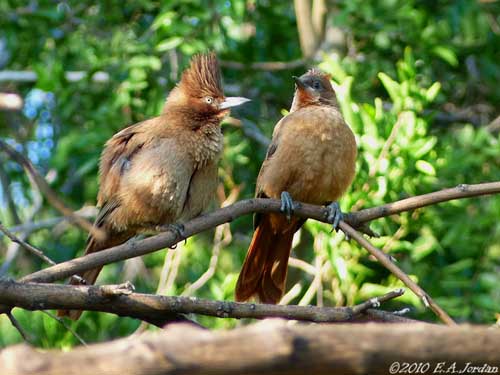
The White-eared Opossum (Didelphis albiventris) is the main predator of this species.
The Spot-winged Falconet often occupies the abandoned nests.
DIET:
The Brown Cacholote feeds mainly on insects and their larvae, coleopteran, large ants and numerous others. It also takes birds’ eggs, seeds and some fruits.
This bird forages mainly on the ground, and occasionally in trees.
PROTECTION / THREATS / STATUS:
The Brown Cacholote is uncommon to fairly common in most parts of its range, and can be seen in several protected areas. This species is not currently threatened.
